
Competition in the marketplace is fierce, and trends come and go.
While this is always an ongoing challenge for online marketers when analysing search results, it’s essential to know what common Google search terms people are using online to learn what the new topics are in different marketplaces.
If you have an e-commerce enterprise or service business in Australia (or wherever you are located), keeping abreast of the latest trending searches and topics is critical to improving business performance.
Google Trends is a great tool for getting the information you need.
Google Trends is a Google website that anyone can access to identify and review trending searches. You can use Google Trends data to analyse popular search queries typed in Google search across different segments, languages, and regions.
Aside from showing daily and real-time search trends, Google Trends also populates graphs and utilises other tools for comparing search volumes. Searches comprise different queries within a specific timeframe representing different regions.
Using Google Trends for Australian searches
Using Google Trends data for Australia to identify emerging topics across the country is quite straight forward.
Here are six ways you can use Google Trends data to find what people are searching for online.
1. Find niches with Google Trends
If you’re thinking of introducing a new product or want to branch off into a new business niche, Google Trends is the tool to use to find new Google search terms.
To ensure the niche you’re checking is stable, change the date range in Google Trends to ‘2004-present’ or ‘Past 5 years’ instead of ‘Past 12 months’ after inputting the search term. There are other timeframe options available in Google Trends also, such as ‘Past 7 days,’ custom range, and more that you can select from.
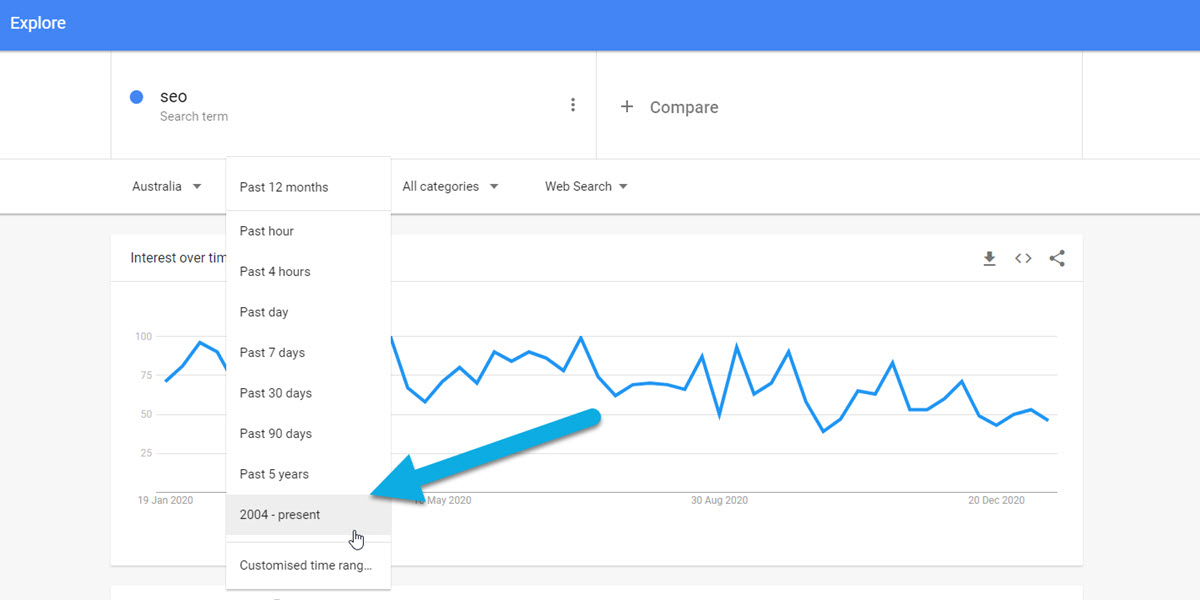
For example, you’re planning to sell sustainable jeans in Australia or specific states in the country. You can type the search term ‘sustainable jeans’ into Google Trends and see the search volume through the years.

You may notice that Google Trends shows periods of peaks and troughs or even flat lines indicating zero search volume (which shows for many periods in the image above). Although the trend is peaking globally this year, Google Trends shows sustainable jeans may not yet have the market size you want in Australia.
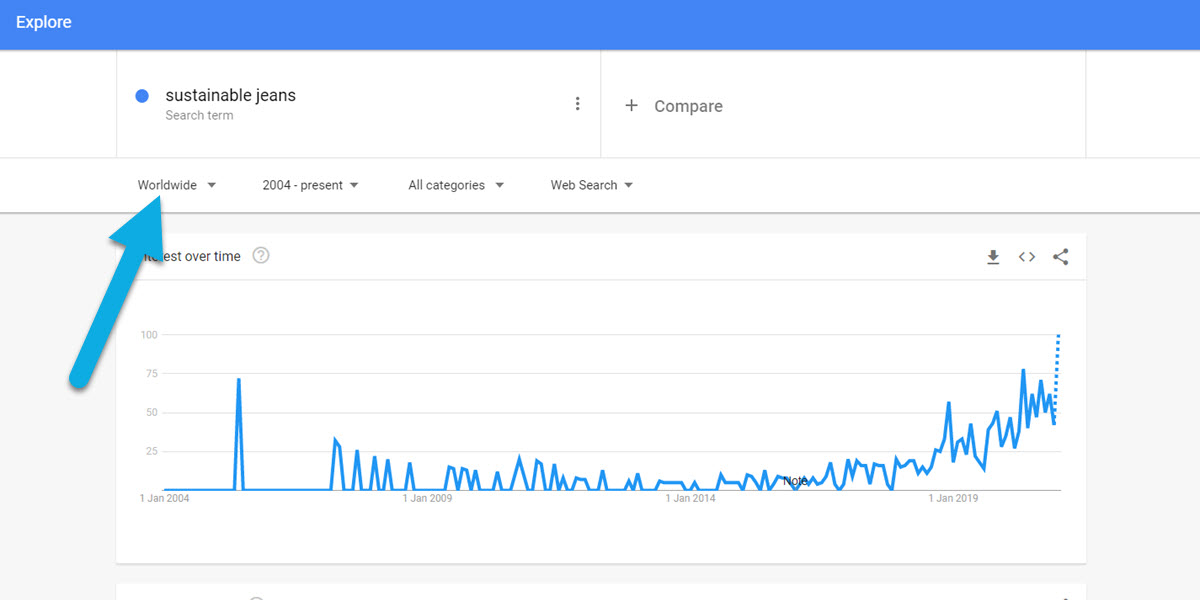
In case you’re interested in selling overseas, too, you can change the locality in Google Trends to worldwide.
Using a timeframe for the past 5 years, you may discover that the global trending searches indicate a relatively steady rise in interest, search volume providing a more favourable outlook.
The same results shown in Google Trends may indicate that the search volume for the term in Australia has been pretty decent in the past 5 years. This means there’s still hope of selling your eco-friendly jeans locally.
What you can do if you feel unsure is to continue monitoring trends over time, or speak to your local SEO provider and have them run some analysis and reports for your business. You could even conduct the basis of an SEO keyword research analysis using Google Trends and other platforms such as Google Keyword Planner.
2. Google Trends can help identify relevant product categories
Let’s assume you’ve already established your eco-friendly empire built solely on denim pants and you are planning to expand your product offerings. It’s now time to find SEO data on related topics and related queries.
Going to your sustainable jeans Google search term page, you will find a list of related topics. Here, you can locate related topics that may or may not be directly linked to your products or service offerings.
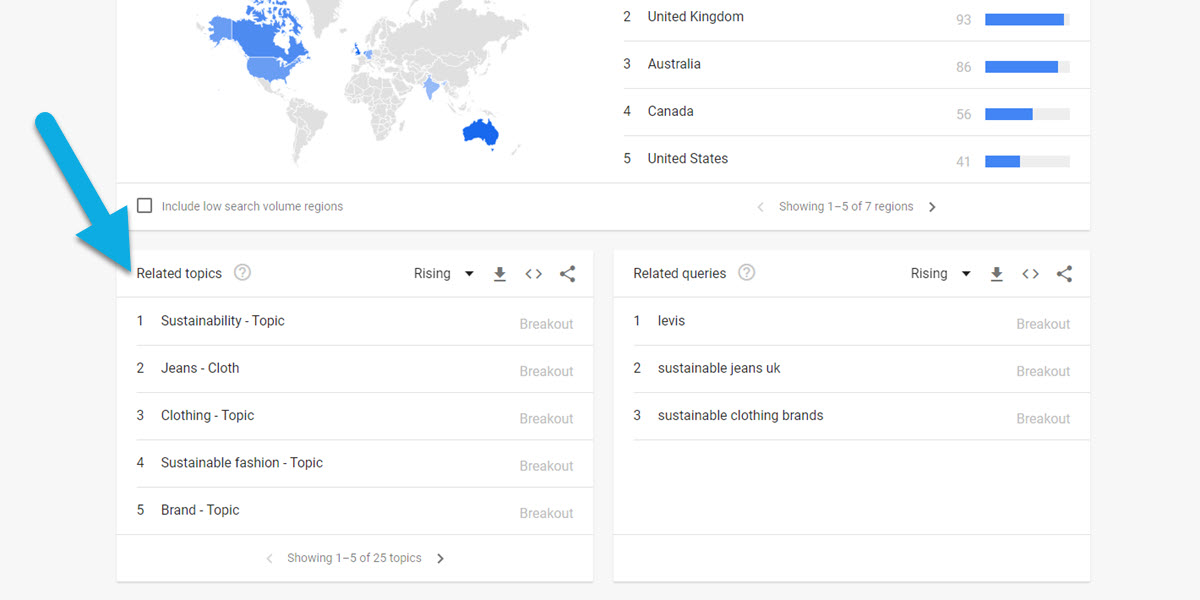
The top five related topics for sustainable jeans are ‘Sustainability’, ‘Jeans’, ‘Clothing’, ‘Sustainable fashion’, and ‘Brand’. These are related to the search term, but they don’t all represent a new product category.
Users tend to search Google in many different ways. Understanding how users search and the Google search terms they commonly use will give you an advantage over competitors.
You may use Google Trends to highlight these related topics, providing you with a basis for introducing a new product. Then, have your SEO copywriter draft up some compelling SEO content for each product and category page. However, make sure you search for the terms that apply (eg. sustainable fashion or sustainable jeans) on Google Trends first and check for any data on related searches.
3. Google Trends helps you know which search term to target
Let’s say you’re now selling vegan cheesecake.
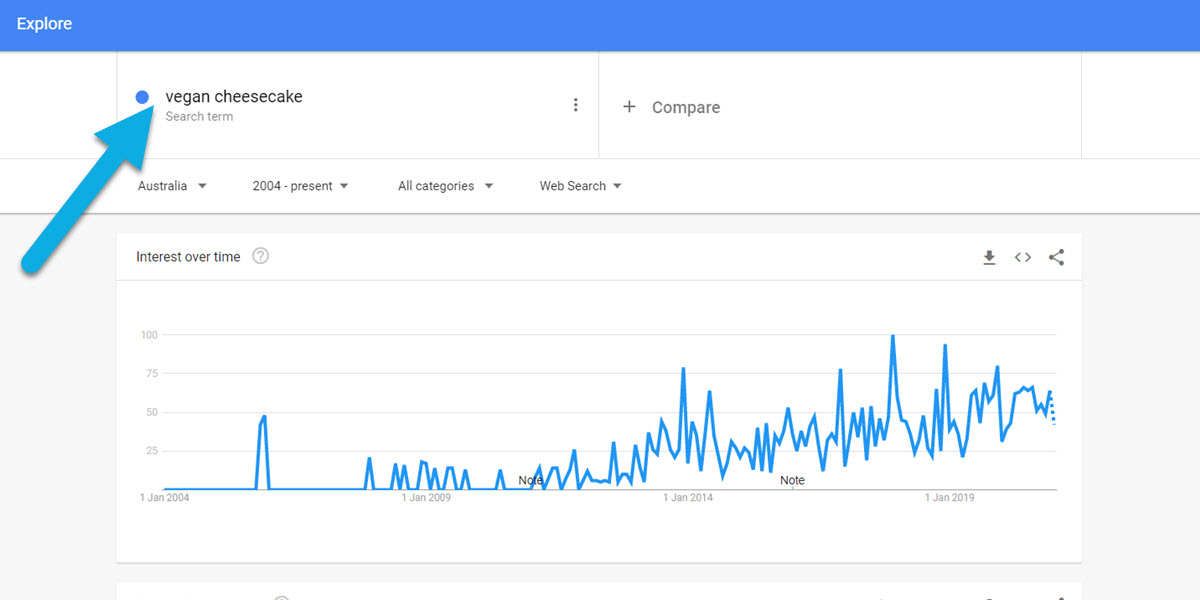
After focusing on an Australia search in Google Trends for the term ‘vegan cheesecake,’ you are able to establish with confidence that your product is likely to remain popular in years to come (see that big trend increase above!).
Furthermore, Google search trends data show that search volume for the term is highest in South Australia, Victoria, and Queensland — which are actually your biggest markets.
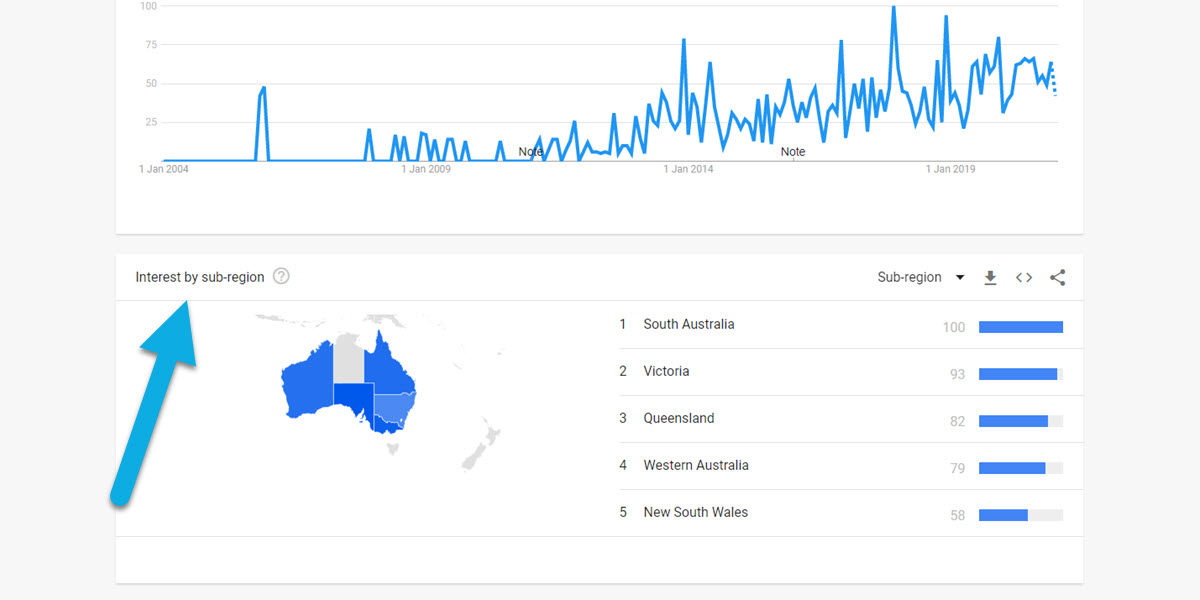
Now, you want to know what other related queries and keywords you can use in your product categories and blog posts. You need to turn your attention to the ‘Related queries’ section on the lower right-hand side of the results page.
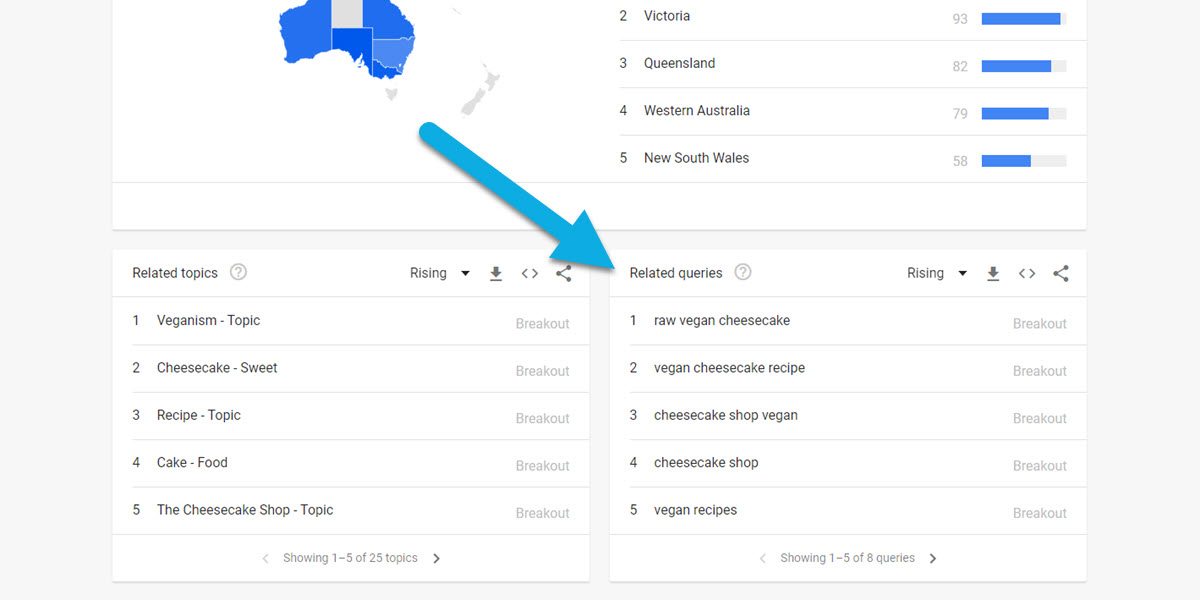
Inside the related queries, you will find related phrases like ‘raw vegan cheesecake’, ‘vegan cheesecake recipe’, ‘cheesecake shop vegan’, ‘cheesecake shop’, ‘vegan recipes’ and so on. You can then consider adding these related queries within your existing content or create new unique blog articles for SEO purposes.
4. Promote products based on seasonal trends and search volume
Going back to keyword research and trends for vegan cheesecakes in Australia, a Google Trends search will show that there are more or less demand and search volume for your product all year round (based on the past 12 months as a timeframe).
You might also notice that search volume peaks in May (Mother’s Day), with search trends showing another uptick toward the end of the year (holiday season). This indicates that people are searching for vegan cheesecakes and recipes in the lead up to special occasions or events.
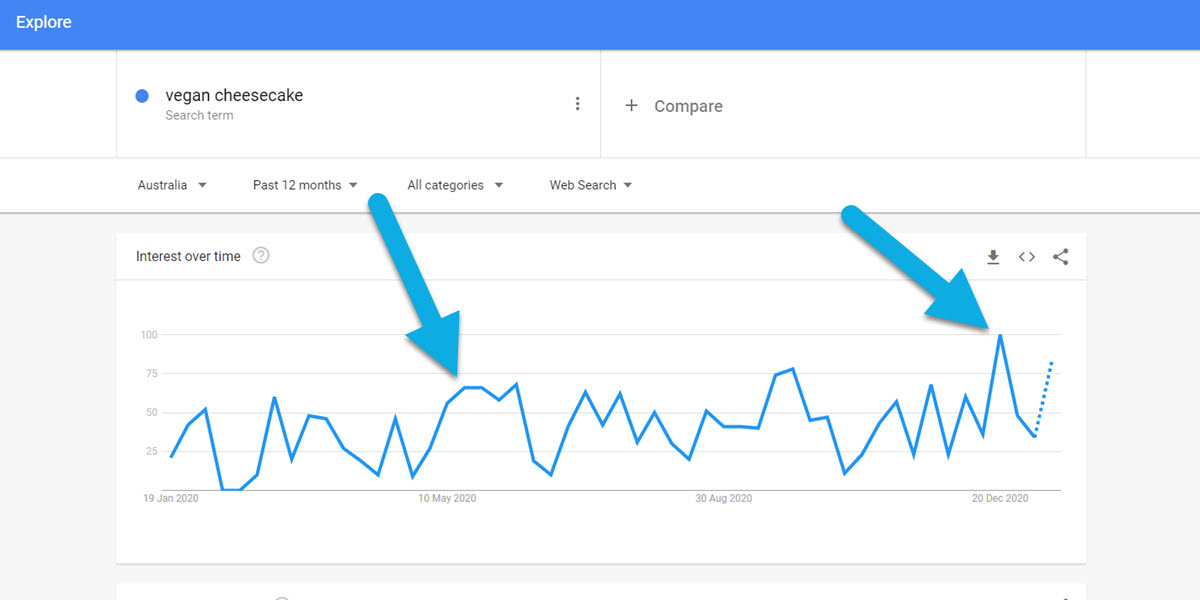
If you’re promoting online through social media and your e-commerce store, it is a good idea to start scheduling your promotions a few weeks prior to these events.
You may even offer early-bird discounts to vegan cheesecake consumers who order theirs ahead of the coming season or holiday.
Also, since search volume is already quite high in Queensland and Western Australia within the past 12 months, consider ramping up your promotions or scheduling them earlier in other states. This could mean directing more of your campaign efforts toward your Victoria, South Australia and New South Wales markets to increase interest.
5. Keep content fresh with Google Trends
Content marketing is not only an essential aspect of SEO, it also helps to establish you as an industry expert and builds your brand. You can use Google Trends Australia for keyword research and emerging topics to keep your published content performing well by either publishing new content or updating existing content.
Obviously, of the two, updating is commonly easier, especially if you have already published volumes of content.
Now, use Google Trends Australia to search for a topic or keywords you might have already written about a lot: vegan meals.
Looking at how this search term performed in the last 12 months, you discover in Google Trends that it’s been searched again and again across Australia.
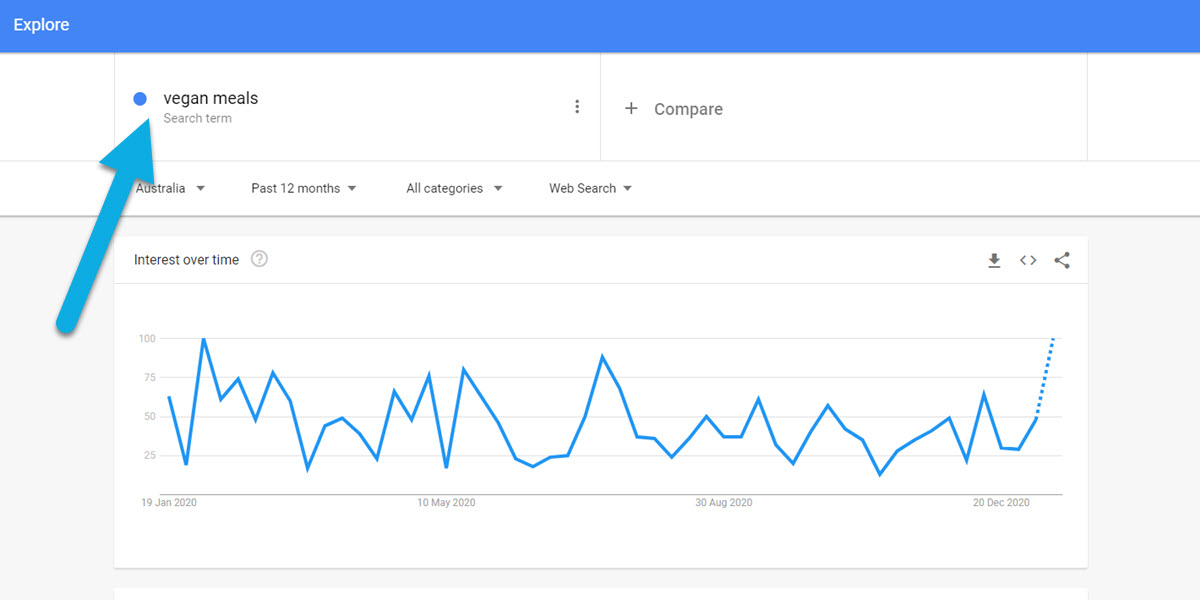
You also notice that Google keyword trends for the term tend to peak in January (when there are lots of important Australian holidays), February (Valentine’s Day), and May (Mother’s Day).
So, you can simply do a content refresh on your posts that talk about vegan meals and related keywords just before those months. By the time more people start searching for vegan meals or recipes again, your posts can rank higher, and your website can perform better.
The above may make it sound a bit less complicated than it can be, but it gives you a good idea of how to use Google search trends to find related search queries and update content with new keywords to keep it fresh.
6. Use Google Trends data to understand where users are searching
Not only does Google Trends provide information on how users search Google (web search), it also covers search volumes and trends from YouTube, Google Shopping, Google Images and Google News.

- Web Search: The most common use for Google Trends, web search can be used to understand what your customers are typing into the search box on Google. From here, you can create dedicated landing pages covering each specific keyword and keywords found in the related search table.
- Image Search: Image search is most important for specific industries, however, can be used by any business to reach customers on a visual medium. If your SEO strategy includes campaigns around traffic from website images, analyse the search volume index for image searches.
- News Search: Find trending news searches and topics that users in your region show interest in. After analysing the keywords and data, you can create news articles and feature articles based on what is trending.
- Google Shopping: If you run an online e-commerce store, there’s not much more rewarding than finding a trending search and capturing those leads. Use data from Google search trends to create content on your product descriptions to match the trending search data.
- YouTube Search: Understanding YouTube trends allows you to capture users seeking video content to entertain, teach or explain a certain topic. Use YouTube search data to find keywords and trending topics, the satisfy these searches with videos you create.
If your business is using multiple avenues to drive traffic, as most businesses should be, Google Trends Australia will give you data on any given trending topic. If you notice that there is an increase in search traffic on YouTube for ‘vegan cheesecake’, it might be worth investing in some video content such as a video recipe guide or tutorial to capture users searching that specific keyword.
While you may have a good idea on how customers usually find your business, Google Trends will help you explore new possible channels you could use. Search Google Trends for a trending topic on each search platform and create blog articles, stories, guides using compelling language to help generate interest and prompt conversion.
Put your new found data into practice
Google Trends is great for some preliminary research, but now it’s time to put it into practice. Speak to the team at White Chalk Road to create a holistic SEO strategy for your business.
Start with Google Trends for improved keyword research
The benefits of using Google Trends to identify emerging topics in Australia and elsewhere do not end here. But now that you know how to use Google Trends, we’ll leave the rest to you.
You can enrich your Google Trends search for topic ideas by using other tools and consulting with an online marketing agency. By deciding to use Google Trends, Google’s Keyword Planner tool and additional SEO platforms coupled with expert advice, you’ll gain more insights about your industry and common search terms to develop a better marketing strategy for your business.
Have some additional questions about Google Trends? Contact White Chalk Road today.
Frequently asked questions about trending keywords
Use Google Trends to find trending keywords by typing a keyword into the search bar and reviewing how the search term's volume has changed over time. The higher the search volume, the more popular the keyword. For keywords with an ever growing number of searches, this is usually a good sign to target it if it's a relevant term.
You can use Google Trends to see how popular a search term is by looking at the search volume, and how this has changed over time. You need to relate this search volume back to similar keywords to see which variation of a term is the most searched, eg. the most popular.
You can use Google Trends data to understand what people are searching for and cater your website to answer these queries and bring traffic through writing content. Google Trends gives a lot of good information on how a keywords search volume has changed over time so you can assess the industry trends and popularity of a particular term. To learn how to use the platform, read out Google Trend guide.




